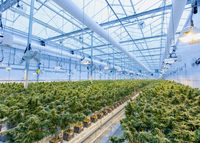Growing the ‘green’ can be anything but green
Cannabis production is estimated to use up to two percent of all of Canada’s electricity, making it more energy-intensive than the mining industry.* Most legal Canadian cannabis is grown indoors as it’s easier to control the lighting, humidity, pests, etc., and create more harvest cycles and grow more plants in a secure location. That means that indoor grows are thirsty for water and hungry for electricity for high-intensity grow lights and ventilation/cooling systems. When you add the use of carbon dioxide to accelerate plant growth and the potential use of (allowed) pesticides, the growing of a plant that Mother Earth gave us is not looking so eco-friendly. It’s been estimated that the carbon output from the production of one kilogram of indoor grown cannabis is equivalent to 11 coast-to-coast car trips across North America (up to 4600 kg).*
It’s not all bad news though, as illegal grow ops that typically used three to 10 times the energy of an average house are being replaced by legal hybrid greenhouses that harness the power of the sun and rain to cut down on the carbon footprint and use less resources. Licensed Producers (LPs) are also exploring innovative ways to make their growing methods and packaging and products more environmentally friendly.
To celebrate 4/20 and Earth Day falling in the same week, we look at ways that you can make your green a little greener...
 Photo by Richard T on UnsplashPick biodegradable packaging
Photo by Richard T on UnsplashPick biodegradable packaging
There’s no getting around the fact that legal Canadian cannabis has a ton of packaging, which is due to Health Canada regulations around needing it to be child-proof and secure. Most of it is recyclable plastic or paper, but some LPs are going the extra step of cutting down on plastic altogether and opting for dried flower in glass jars (try Simply Bare and Joi Botanicals), or even making packaging compostable/biodegradable (meaning it breaks down naturally over time). Stewart Farms uses biodegradable packaging for cannabis-infused bath bomb products and Wyld uses bio-based compostable packaging for their gummies. The film, adhesives, inks and zippers are made from materials such as bioPBBS, cellulose, and bio resins that can be composted at home.
Other LPs use biodegradable elements. Everie’s cannabis-infused teabags are fully biodegradable and Illuminate Cannabis Co’s Doob cylinders are 3-D printed using PLA Plastic Filament (Polylactic acid), which is a renewable and biodegradable plastic made from corn starch.
Opt for plant-based plastics
Without getting too meta, cannabis can even be used to create its own packaging. Plastics are derived from cellulose (usually from petroleum) and hemp-plastic is made using cellulose from discarded hemp stalks that are otherwise dumped or burned, so reusing them is a double win for the environment. This hemp-based bioplastic is stronger and more flexible than standard plastic.
Some cannabis companies have started using it to house cannabis concentrate products. Mood Ring makes vape cart mouthpieces out of hemp-plastic, which uses 20 percent less plastic and has a 32 percent lower carbon footprint than traditional plastic mouthpieces. They also use plant-based inks and the plastic elements have a special organic compound added that means they will biodegrade in a few years versus the usual hundreds or thousands of years for typical plastic mouthpieces.
Growing green
While greenwashing can occur in cannabis, there are some clues that your cannabis product is having less of an impact on the earth. Flower that is labelled as organic, sungrown, or grown with aquaponics is likely to be less energy intensive than cannabis grown in a big warehouse.
While there is no Canada-wide official organic label, most growers adhere to the Canadian Organic Standards, and growers tend to be certified via an organization such as PACS (Pacific Agricultural Certification Society) if they are using growing methods that help create natural stability. These might include maintaining a living soil, using insects to control pests, water management, and promoting biological diversity. Certified organic growers include Rubicons Organic (Simply Bare) and TGOD.
Sungrown cannabis doesn’t mean it was grown outdoors, but it does mean it was grown in a greenhouse (as opposed to a warehouse) and the growers use natural light or a sunlight and LED light hybrid instead of intensive lighting. Greenhouse growers of sungrown flower, such as Tantalus Labs and Pure Sunfarms, also tend to use other eco-friendly methods, like reclaiming rainwater to cut down on the environmental impact.
Some LPs like Sweetgrass use ‘living soil’, which contains a natural ecosystem with additions like earthworms to keep the biology using microbes and critters. Some growers use mediums like coco coir (coconut husks) instead of peat as a more sustainable option that requires less water and added nutrients.
Hydroponics, growing plants in water, uses about 10 percent of the water needed to grow plants in soil and the same applies to cannabis cultivation. Aquaponics, combining hydroponics and fish, is becoming more popular in cannabis cultivation with LPs such as Stewart Farms and Reef Organic products by Aqualitas using a closed-loop recycling system to save water and use fish by-products (poop) as a natural nitrogen-rich nutrient.
Have a happy, earth-friendly 4/20 with greener green.
*Source: Tantalus Labs

